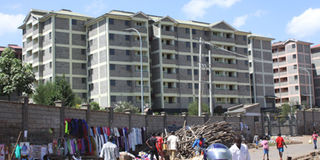Innovate housing financing for affordability

The government is to put up more that 3,000 housing units in Soweto in Kibera, Nairobi, in a slum-upgrading project. PHOTO | FILE
What you need to know:
The African housing market is valued at $332 billion and against an annual $32 billion mortgage market, which represents a 90 per cent room for growth.
There is a need for better incentives for mortgages in order to improve the levels of qualifying demand.
More innovation in supply and demand is imperative to increase the levels of qualifying demand while leading to the large-scale production of affordable homes.
Affordable housing in Africa should be addressed from two very critical interdependent sides: Demand and supply.
Governments are typically keen on providing mass housing by offering incentives to stimulate the supply side and subsidies to enhance affordability, critical to stimulating demand.
CAPITAL RESOURCES
Generally, they prefer delivering the house and taking full control of the process. But that is not pragmatic due to limited capital resources, given the size of the housing shortage.
Most housing policies harp on boosting supply. However, developers and construction companies are more interested in maximising profit and gravitate towards the middle- to high-end market. That leaves large sections of the lower end of the food chain unhoused or housed inadequately or indecently.
PROSPECTIVE OWNERS
Recently, however, African governments have taken a dual approach to intervene with the supply side of building houses and demand side to purchase them. They promote boosting of housing supply while exploring ways of improving demand through subsidies that help to enhance affordability and comprehensive borrower education for prospective homeowners.
Interestingly, there is a perception of a burgeoning demand for housing while the cost of houses make them unaffordable.
A study by the Centre of Affordable Housing last year estimates that the cost of an affordable unit in Africa should be $7,500 (Sh750,000) by industry standards, albeit this price point being unattractive to profit-seeking developers.
ENHANCE DEMAND
At that price, housing demand amounts to a staggering 52 million units. Only eight African countries could afford houses for more than 50 per cent of the population at that cost.
In 29 African countries, less than 10 per cent of the population would afford the cost of the unit. In Ghana, that number is five per cent and Malawi three per cent.
That points to two major observations. First, we cannot conclude that Africans are not purchasing houses because of the price without an understanding their level of affordability.
Secondly, there is a need to enhance demand for housing to make it effective. Less that five per cent of the prospective homeowners who apply for housing finance are approved.
LEAPFROG MODEL
But what is affordable? Is there an index of affordability we can ascribe to? How is Africa rising if a significant number of Africans cannot afford affordable housing?
Innovation is the mantra du jour; we are witnessing the potential of Blockchain to revolutionise transactional businesses, and how Artificial Intelligence will make life more efficient. It is no different for Africa and, given the prevalence of information sharing using the “leapfrog model”, Africa can skip several development steps by deploying new and innovative thinking.
With innovation, sometimes all that is required is to pay attention to a process. This leads us to the potential of informal land holdings and the potential for mortgages of the unbanked.
DEAD CAPITAL
Peruvian economist Hernando de Soto coined the term “dead capital”, for underexploited assets. A report in the Economist magazine says De Soto put, 21 years ago in 1997, the value of Africans’ informally owned houses and farmland at roughly $1 trillion — nearly thrice Sub-Saharan Africa’s annual GDP and more than 70 times the aid the continent receives yearly.
The principle is simple: If we formalise the unbanked and tie this to property rights, Africa would see an explosion in new affordable housing possibilities for those who need it the most.
Investment behaviour tends to be more long-term and bullish if the investor feels secure, for instance, and the patch of land is guaranteed by owner rights.
UNLOCK CORNERS
It would be folly, however, to expect that that can be done immediately. It has taken some developed countries centuries to evolve these rights and, as we have seen with Blockchain, they are still changing. But we can determine best practice and sometimes this can also mean cultural practices.
There is a need to resurrect this dead capital and unlock these corners of our economy. This need transcends housing.
The consumer market in these corners of the global economy is an estimated $5 trillion. The African housing market is valued at $332 billion and against an annual $32 billion mortgage market, which represents a 90 percent room for growth.
BETTER INCENTIVES
There is a need for better incentives for mortgages in order to improve the levels of qualifying demand. More innovation in supply and demand is imperative to increase the levels of qualifying demand while leading to the large-scale production of affordable homes.
Mr Chimphondah is the chief executive officer and managing director, Shelter Afrique.





